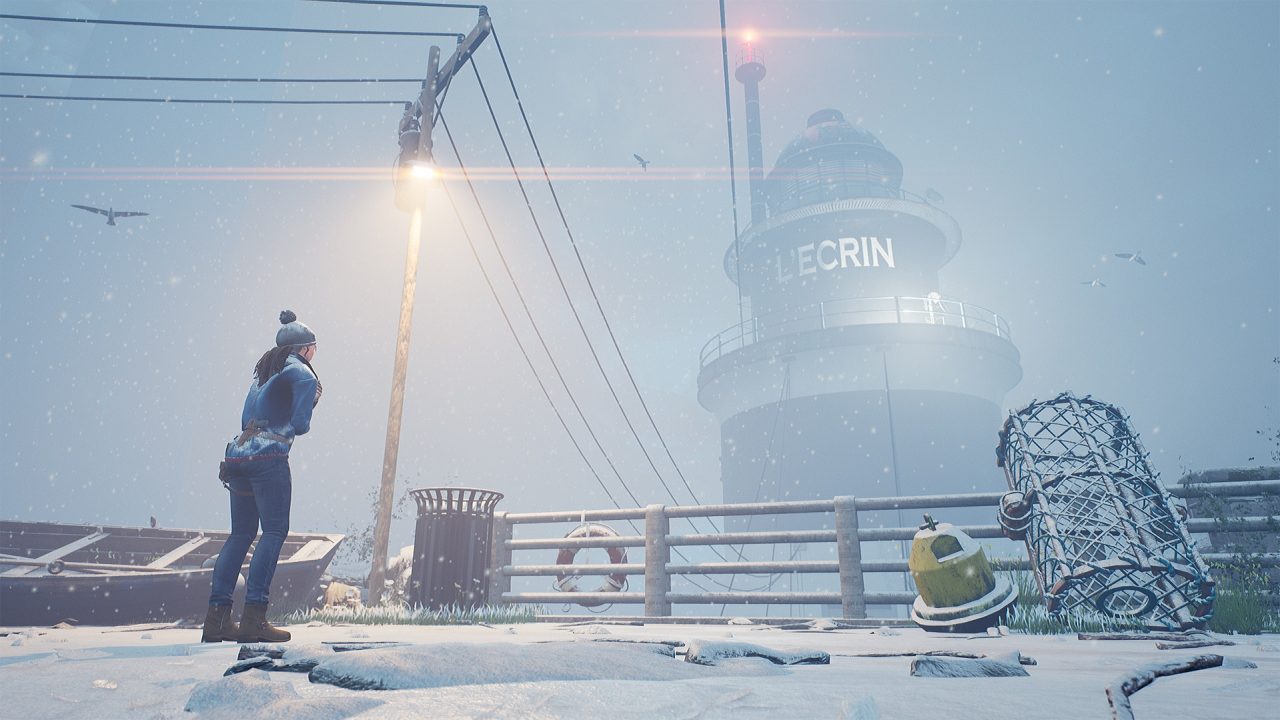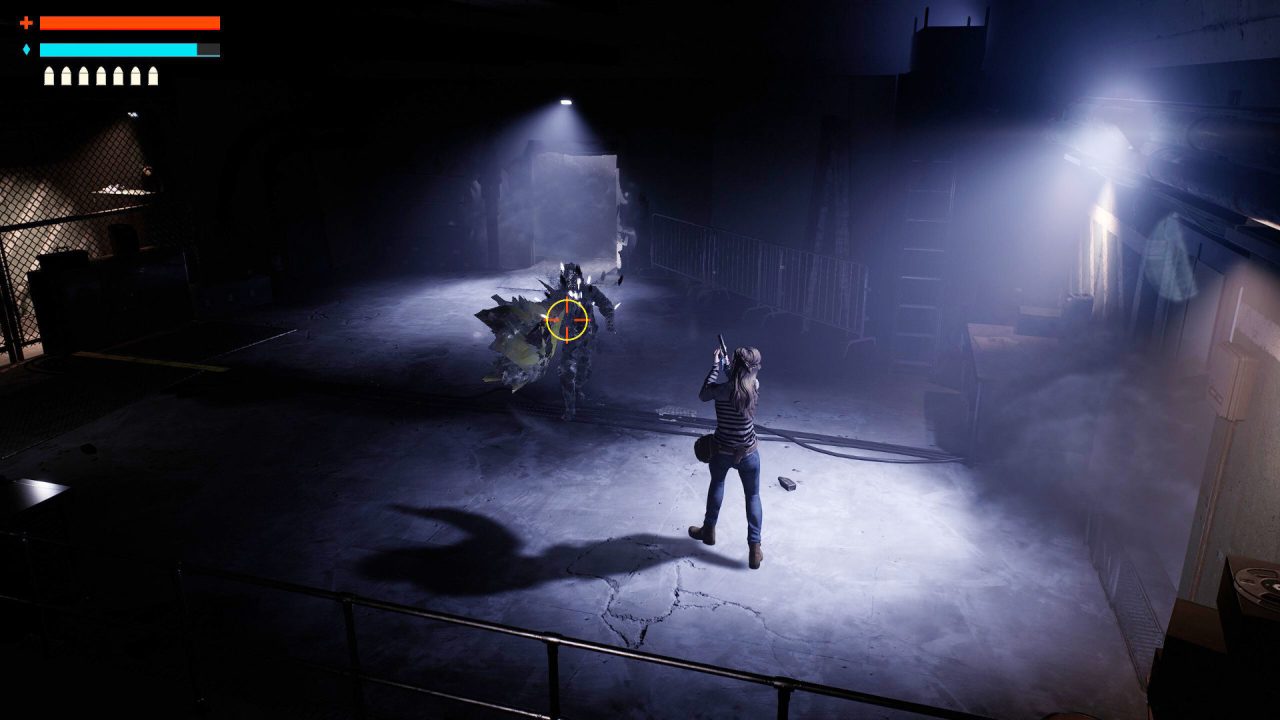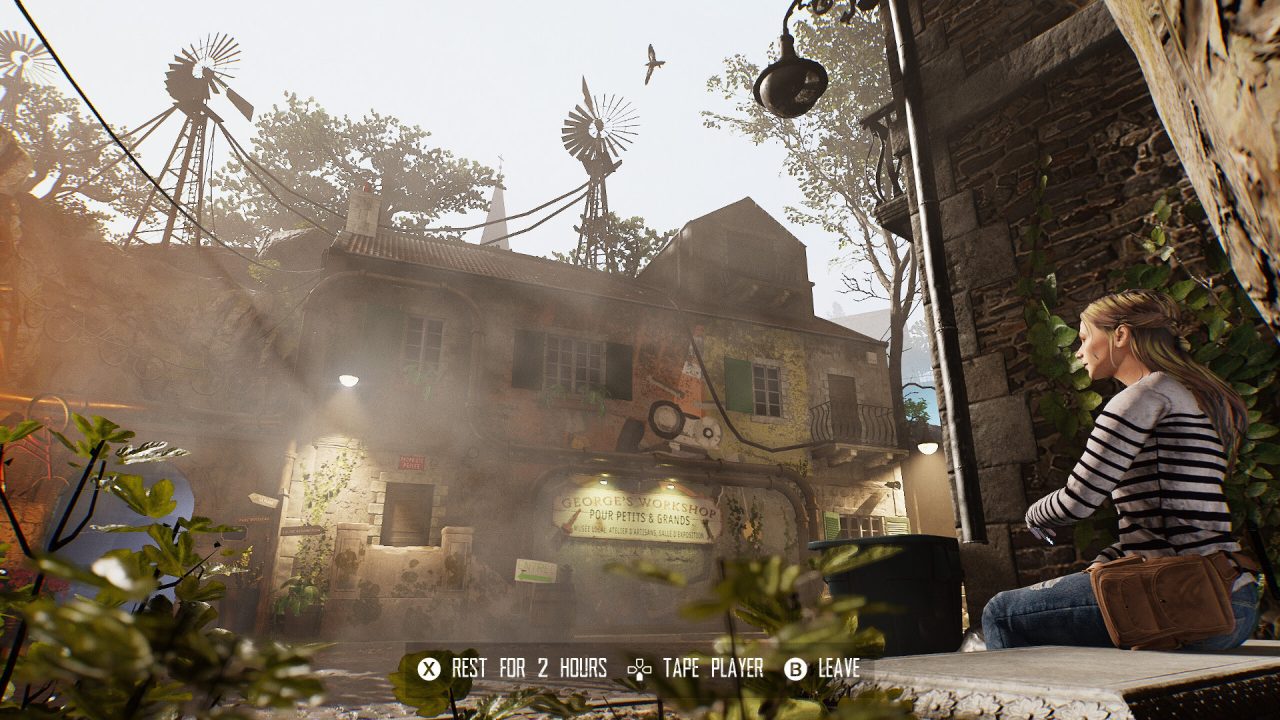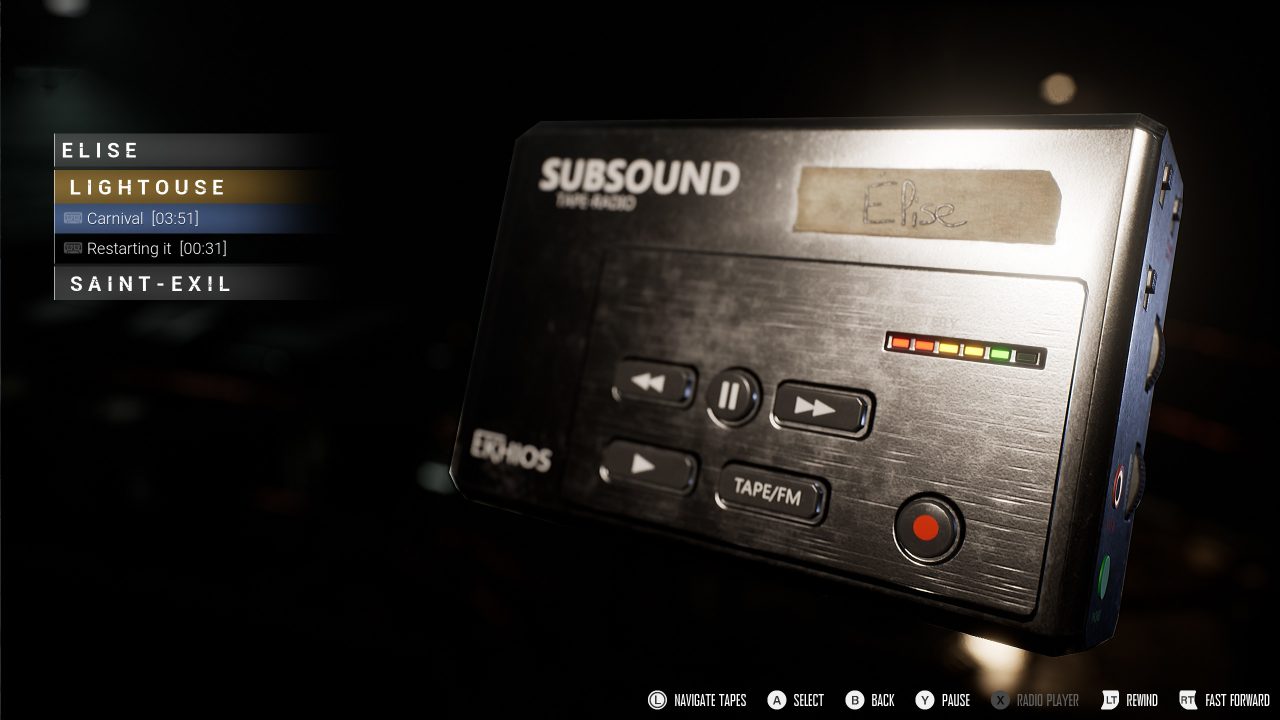Sometimes, all we can do is gather up the broken pieces and hope they will form a coherent whole. That certainly seems to be the case with the adventure game Broken Pieces, but once all of the parts of this indie title come together, does a complete picture take shape? Unfortunately, the result seems to be missing a few pieces to help give the game and its mystery narrative a clearer picture.
Set sometime in the nineties, Broken Pieces takes place in a fictional remote French coastal village called Saint-Exil. Something horrific has happened to the town and its residents. Several days before the start of the narrative, everyone went missing. Only Elise, a thirty-something woman who recently moved to Saint-Exil alongside her fiancé Pierre, remains. Every day since that terrible incident, she tries to decipher what happened and how she might escape the area. Can Pierre and the other townsfolk still be saved? What is the truth behind the shadow creatures occasionally attacking Elise throughout town? Is there something lurking under the water near Saint-Exil? What is happening with the military presence and the disturbing cult known as The Devoted? Elise spends her time during the story trying to find answers to those questions.
The gameplay in Broken Pieces comprises cyclical loops. Every day for Elise begins promptly at 8:00 AM when she emerges from the empty home she used to share with Pierre to explore the surrounding areas of the town. The town is sectioned off, with locations farther away from Elise’s home taking more time to reach (generally an hour or so off the in-game clock). Elise can investigate areas until it starts getting dark. At this point, she should return to her house to rest, as the unpleasant shadow entities appearing in Saint-Exil become more active at night. This cycle of Elise waking up, investigating, then heading back to the safety of home before nighttime makes up the crux of the gameplay. As Elise moves through a given area, she’ll encounter interactive objects of interest. Sometimes she finds valuable items in places such as trash cans or a feature of the location that might shed more light on the disappearance of the town’s population. She can collect other objects to solve puzzles that advance the plot or grant access to previously sealed-off map sections.

Puzzles can be a boon to mitigating the cyclical trudging from area to area or a source of much head-scratching and frustration. I spent more time trying to solve certain puzzles than I care to admit. Sometimes clues aren’t appropriately recorded in Elise’s handy journal, or the secret to solving the puzzle isn’t clear-cut until you can further explore other areas of Saint-Exil. I found puzzles at the beginning of the game to be reasonably easy to understand based on the information given. Still, later puzzles were often more challenging and required more experimentation before revealing their secrets. For instance, an optional puzzle where you’re supposed to find boat plate numbers doesn’t record them in your journal. Another puzzle where you have to distract birds entails throwing items onto an area field until the game “clicks” with what you’re doing and labels it a success. I repeated that bird quest doing the same action, but at different areas on the beach because I knew that was the solution. It took several attempts before the game registered my actions as accurate. Puzzles sometimes require a tedious level of trial and error.
You also have to remember how much time you are spending throughout the game. So, even if you’re in the middle of solving one of the more complicated, multi-staged puzzles, once it is late in the day, you might want to have Elise hightail it back to her house to rest for the night before finishing the puzzle. The constant back-and-forth only adds to the frustration of puzzle-solving as there is no real fast-travel solution. Objectives aren’t the clearest with regard to what you need to do to reach the next, with some only unlocking after bringing home “nighttime reading” materials that require Elise to once again backtrack to the house to access them properly.
The camera angles can also add a bit of frustration to the game’s exploratory and puzzle-solving experience. Broken Pieces utilizes a third-person perspective with two different angles for the camera that you can switch between with the press of a button. It is sometimes vital to do so, especially if you feel you’ve combed through an area and still haven’t unlocked a new clue or objective. It is likely not to notice something of import in one camera angle versus another. There is also a stationary first-person perspective you need to utilize at times to uncover better visual cues (such as what the correct order is for the colored wires for security doors), which is helpful but not the most freely adjustable camera angle. If you’re not standing in the right spot beforehand, the odds are good that you’ll miss that one vital clue. Each time I had to use the first-person perspective, I wasted several minutes positioning Elise before I was finally able to find the missing piece.

Elise has several helpful tools she can use during her investigations. Her journal is one of the most vital for collecting valuable intel and useful clues, though admittedly, it isn’t quite as thorough as I would’ve liked when it came to the later, more complicated puzzles. The other tool she constantly carries with her is a unique, somehow-magical bracelet that allows her to change the weather around her to stormy conditions briefly. Using the bracelet helps fell trees or topple bridges to create new paths. Later in the game, her bracelet inexplicably gains the ability to turn the weather snowy when it is submerged in water at outside sinks, altering the terrain quite a bit and even impacting the tides and structural integrity of certain buildings. Knowing when to make things snowy or stormy is key to further exploration and puzzle-solving, though frustratingly enough, you’ll first have to backtrack to the house to get snow gear. Elise picks up found cog pieces or levers that, when added to unresponsive machinery, can get the mechanisms moving again, or she collects axes that can help knock over trees or break barriers. She also has a music tape player that she can listen to found tapes on for vital clues as to what to do next, with the game noting that listening to any found cassette is sometimes imperative to advancing the plot. Elise also needs space in her limited inventory for her gun and precious ammo. Ammo is limited; you create more of it by putting crafting materials in a storage chest overnight. There is an option to upgrade your gun if you find the materials. However, I never did and got through the game just fine.
Given that Elise does start the game armed, it should be no surprise that combat plays a role in Broken Pieces. You get a brief tutorial about its mechanics before venturing out of the house the first time, and it isn’t long after before you have your first encounter with shadowy enemies. Unfortunately, they’ll be a frustrating bane whenever they show up, mainly because the game’s combat is so clunky and unintuitive. In theory, you target-lock onto an enemy and open fire, dodging and repelling those who get too close with simple button commands. Unfortunately, I found the controls for combat to be more on the sluggishly unresponsive side, making the experience feel more like a stressful chore than something the game inherently needed. There is an option at the start of Broken Pieces to begin the game in a Reduced Combat mode. I’d probably recommend most who give the game a try take advantage of that option, as the combat sequences are easily the weakest element of the title and seem more like an afterthought.

The game does auto-save at specific points, like waking up in the morning or when you first enter a “memory stage.” However, saving by sitting on benches scattered throughout Saint-Exil is the only way to save manually. You can also rest on a bench to replenish health at the cost of a few in-game hours, and Elise can also restore health by going through her fridge at home or a restaurant. Because the benches appear frequently, I never felt like there was a real danger of losing a lot of valuable game time if I remembered to sit at one every so often.
Exploration, puzzle-solving, and the narrative are the main driving forces behind playing Broken Pieces. I think the description of it as a “psychological thriller” and gameplay elements it has in common with the survival horror genre are doing the title a disservice. The game isn’t scary at all, with only the occasional mildly disturbing or unsettling point. Broken Pieces is more of a mystery adventure title with some shoddy combat inexplicably thrown into the mix. When you successfully solve a puzzle, you get a strong “Aha!” moment, and uncovering the locales of Saint-Exil is intriguing. I even like the “memory portal” elements, where you deep dive into an alien terrain that connects to Elise’s innermost thoughts and memories while offering a bit more challenge in puzzle-solving and (sadly) combat. However, it is the strangely compelling mystery as to why the town is empty and why Elise is there at all that are the main driving forces behind Broken Pieces’ narrative.
Because the game consists largely of Elise wandering an empty townscape on her own, an eerie sense of loneliness permeates Saint-Exil. Sound plays into this, too, with the only real effects being seagulls flapping their wings and calling out or the waves hitting against the sides of the dock. Elise’s lone footsteps crunching on gravel or through snow further cause this sense of isolation to permeate and fester. It is no wonder that she narrates so much of her inner thoughts out loud, as I imagine not hearing other people beyond voice recordings for so long can be maddening. Unfortunately, Elise’s puns and jokes could use a little work. Pierre made music tapes for her that you can uncover throughout the game, and I like how you can play them during your travels to help break up the monotony of solitude. The soundtrack is sparse but has a lingering effect, given its presentation.
An example is the vocal song “Aède – Disparu.” The English voice acting harks back to early games of the survival horror and adventure genres: which is to say, it isn’t the best but still holds a nostalgic twinge. There is also a French language option, which makes sense given the game’s setting and the fact that the five-team-member developer Elseware Experience also happens to be French. The graphics are nice to look at, with the background vistas of the village being visually appealing. I also quite like the art that appears when the game loads. The different angles of the camera also help bring to mind early adventure games, provoking a sense of nostalgia.

Overall, the narrative beats and mystery surrounding Broken Pieces start compellingly. Unfortunately, because the title drops players into the aftermath of an earlier event, some things, such as Elise’s magical bracelet, never get satisfactorily explained. Still, the game does a good job filling in the blanks, thanks to the clues you find and the tape recordings. There’s confusion regarding the roles of the military and cult that’s been terrorizing the citizenry of Saint-Exil. However, since Elise never learns the whole story, perhaps the player isn’t supposed to piece it together thoroughly. I found that the main story’s ending is a letdown. It builds up to something significant thanks to the puzzles you must complete to reach it, but the final scene stops without much explanation and just a looming sense of impending dread. I honestly expected there to be something more, thinking I had maybe not finished the game adequately or reached a bad ending. However, the Achievements noted I completed the main story once the credits rolled. It is a testament to how much I grew to like the game despite its frustrations that a part of me hopes there might be more story content coming! The developers did listen to the issues many had with the abruptness of the ending and patched in a tape message recording that plays during the end credits that helps to explain some of the dangling plot threads while still leaving some things open to player interpretation. I greatly appreciate this even though I would still like more answers in general to the questions the plot leaves lingering, but I suppose that maybe not providing them was a creative choice by the developers to fit the narrative’s “broken pieces” theme.
Broken Pieces is an odd, disjointed game with unnecessary combat, tedious back-and-forth exploration, and frustrating puzzle designs. And yet, I found myself wanting to explore Saint-Exil with Elise to figure out its mysteries despite those flaws, to the point that I was honestly a bit disappointed at the game’s relatively weak ending. Anyone looking for an exploration adventure game that harks back to the genre’s past and doesn’t take a ton of time to complete should give Broken Pieces a try. Just don’t expect the vase you assemble from all of the game’s pieces to necessarily come together thoroughly enough to hold water.


